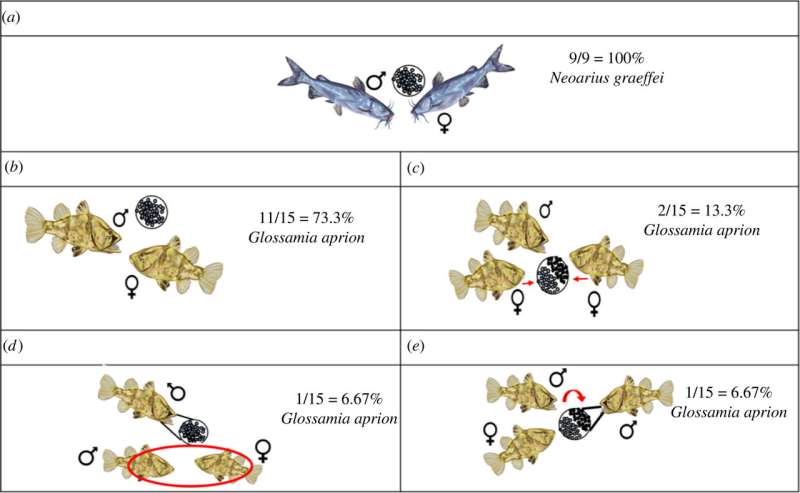May 4, 2022 report
A species of mouthbrooding male fish in Australia carries wildly different egg parentage in its mouth

A team of researchers at Charles Darwin University, in Australia, has found that male fish that mouth-brood are not always guaranteeing that the eggs they carry were fertilized by them. In their paper published in the journal Biology Letters, the group describes their study of the eggs brooded in the mouths of males of two species and what it taught them about monogamy in certain fish.
Mouthbrooding, as its name implies, is a reproductive process by which a creature sucks fertilized eggs into its mouth and carries them until they hatch. Prior research has shown that in some species, the females do the mouthbrooding, while in others, the males do. Prior research has also shown that mouthbrooding takes a toll on the brooder—he or she cannot eat the entire brooding time, which could be a couple of weeks. Also, carrying a load of eggs in the mouth has been found to slow down swimming, making it easier for predators to catch them. In this new effort, the researchers looked at mouthbrooding in two species native to Australia: blue catfish and the comically named mouth almighty.
Prior research has shown that some species of male mouthbrooding fish carry eggs that they did not inseminate. In their effort, the researchers wondered about the paternity of the eggs carried by both of the species under study. To find out, they caught several samples of both species and extracted multiple eggs from each. All the eggs were examined through DNA analysis, along with samples from the brooding male.
The researchers found that eggs carried by blue catfish were as expected—all of the eggs had been fertilized by the male carrying them and all came from the same mother. But things were wildly different for the mouth almighty—approximately 25% of the eggs either had a different mother or had been fertilized by another male. In one batch of eggs, they found that all of the eggs had been fertilized by another male.
The researchers find this conclusion baffling, considering it would seem the whole point of male mouthbrooding is to ensure parentage of offspring. But they suggest that something else might be at play—males carrying a lot of eggs appeared to be more attractive to females, which suggests they could be making up for the loss or fertilization of the eggs they were carrying by fertilizing more eggs overall.
More information: Janine E. Abecia et al, Diverse parentage relationships in paternal mouthbrooding fishes, Biology Letters (2022). DOI: 10.1098/rsbl.2021.0576
Journal information: Biology Letters
© 2022 Science X Network


















